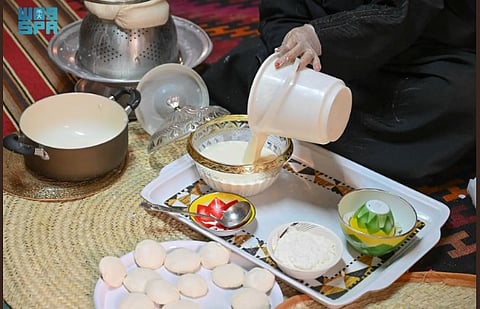

The production of "jameed" (fermented, dried yogurt) and "khathir" (sour yogurt) is a long-standing traditional dairy industry that has been practiced for centuries, utilizing milk from livestock. The term "jameed" is known by various regional names, such as "iqatt" and "mudayir," while "khathir" is also referred to as "roob" or "zabadi."
Many families in the Northern Borders Region continue this time-honored tradition, ensuring its preservation for future generations. Some families have also turned it into an additional source of income, producing jameed and khathir for their households.
Traditional dairy production is thriving in Arar, a city in the Northern Borders Region. In an interview with the Saudi Press Agency (SPA), Zohya Al-Dahmashi shares insights on the process of making jameed and khathir.
Al-Dahmashi emphasized that jameed was made by separating butter from yogurt using a leather bag and boiling down the leftover buttermilk until it became thick. Finally, the thickened product was salted, shaped, and sun-dried for long-term storage without refrigeration.
Moreover, kathir is made using a simple process. Milk is boiled until a layer forms on top.
After cooling, a small amount of pre-prepared khathir is added as a starter culture. The mixture is kept warm for a few hours to ferment and thicken into khathir.
The finished product is stored in a cool, dry place.
Families working in the cottage industry and craftswomen eagerly participate in activities and events organized by government and civil entities.
They present traditional products, old handicrafts, popular dishes, and their preparation methods, which opens up new opportunities to boost their income.
